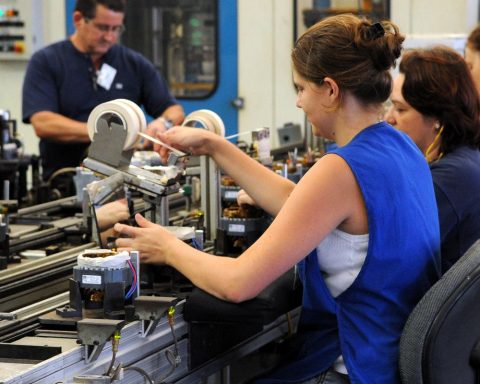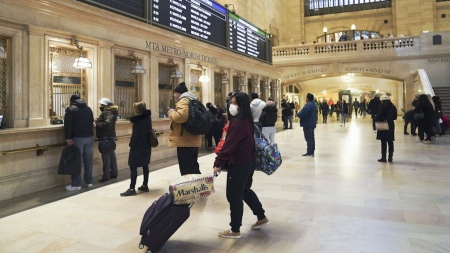Between 2011 and 2021, the number of students in undergraduate higher education courses, in the distance education modality (DE), increased by 474%. In the same period, the number of students who enrolled in on-site courses decreased by 23.4%. If, in 2011, admissions through distance education corresponded to 18.4% of the total, in 2021 this percentage reached 62.8%.
The data, which reflect the expansion of distance learning in Brazil, are part of the results of the Census of Higher Education 2021, released today (4) by the National Institute of Educational Studies and Research Anísio Teixeira (Inep) and the Ministry of Education (MEC). ).
According to Inep, which coordinates the data collection, from 2020 to 2021, the increase in students in higher education was caused exclusively by the offer of distance education in the private network. In this period, the modality increased by 23.3% (24.2% in private institutions), while enrollment in on-site graduations fell by 16.5%. In the private network, 70.5% of students, in 2021, entered through remote courses.
“The comparison confirms the growth trend of distance learning over time. In 2019, for the first time in history, the number of EaD entrants surpassed the number of students who started their on-site graduation, in the case of private institutions”, explained Inep.
Growth
The director of the MEC’s Secretariat for Regulation and Supervision of Higher Education, Vandir Cassiano, said that since 2017 this growth has been more expressive and, given the scenario of the covid-19 pandemic, the EaD numbers have leveraged.
“In 2020, 2021 and, now, 2022, we have an absurd growth, it is something already settled, it is a path of no return”, he said, warning of the need to evaluate the quality of this teaching.
“We are seeing this [qualidade] very carefully, because we have institutions that advertise distance education courses in the amount of R$ 59.90, a very low monthly fee. To what extent does this course offer adequate training for the job market and that will become part of the country’s social and economic context? The secretariat has a work to verify these EaD centers, to treat these authorized centers”, she explained.
The 2021 census recorded 2,574 institutions of higher education. Of these, 2,261 (87.68%) were private and 313 (12.2%) were public. In this context, the private network offered 96.4% of the vacancies. The public network was responsible for 3.6% of the offers.
The number of enrollments also followed the growth trend of recent years and reached 8,987,120. Private institutions concentrated 76.9% of those enrolled and public institutions registered 23.1%. Between 2011 and 2021, the percentage of students enrolled in higher education increased by 32.8%, which corresponds to an average of 2.9% per year.
According to Inep, in the relationship between enrollment and teaching modality, the expansion of distance education was once again evident. In 2021, there were more than 3.7 million people enrolled in distance learning courses. The number represents 41.4% of the total. In the historical series highlighted by the survey (2011 to 2021), the percentage of EaD enrolled increased by 274.3%, while, in the classroom, there was a drop of 8.3%.
Graduation
A look at the ratio of admissions to distance and face-to-face undergraduate courses, in undergraduate courses there was a drop of 12.8% from 2020 to 2021 in the face-to-face modality. Of the students enrolled in undergraduate courses, 61% attend distance learning courses. Regarding the number of new entrants, 77% of undergraduate students opted for distance education courses.
The president of Inep, Carlos Moreno, said that the results of the census point out, in a concrete way, in which direction Brazilian higher education is heading and demand reflections on educational models and policies.
“The future teacher, who will work in basic education in Brazil, will have undergone distance training. So, this is a very important point to analyze the suitability of this strategy [de avanço dessa modalidade de ensino]” he warned.
In Moreno’s assessment, in the case of teacher training, the distance modality can be very efficient when the professional has already had initial training and acquired experience in pedagogical practice. For him, however, there are positive aspects in the expansion of distance education, such as the increase in the number of students in undergraduate courses and the possibility of higher education being studied throughout the national territory “as long as it is of quality”.
From 2020 to 2021, there was a reduction of 4 percentage points in the demand for teacher training courses, from 19% to 15% of vacancies. Of the 3,922,897 students who entered higher education in 2021, 55% preferred a bachelor’s degree, 30% technological courses and 15% a degree. In the federal education network, the average is higher, 26% of students attend undergraduate courses.
Of the 1,648,328 enrollments in undergraduate courses in 2021, 35.6% were registered in public institutions and 64.4% in private ones. More than 80% of undergraduate students from public institutions attend face-to-face courses. In the private network, distance courses prevail, with almost 85% of students.
Among the degree courses, the Pedagogy course prevails, with almost half of the students enrolled (47.8%) or almost 800 thousand students.
teachers
According to the secretary of Basic Education of the MEC, Mauro Rabelo, a recent study points to a lack of teachers to work in basic education from 2040 onwards. , we have a National Conference on Education in progress, which will provide support for this. The census data, then, are of tremendous wealth, it is our governmental scientific basis, of the Brazilian State, for future decision making,” he said.
The objective of the Higher Education Census is to provide detailed information on the situation and trends in Brazilian higher education, as well as to guide public policies in the sector. After the disclosure, the information starts to appear as official data of the educational level.
In addition to supporting the formulation, monitoring and evaluation of public policies for higher education, the census contributes to the calculation of quality indicators, such as the Preliminary Course Concept (CPC) and the Institution’s General Index of Evaluated Courses (IGC) .
The 2021 survey results are available on inep website.















